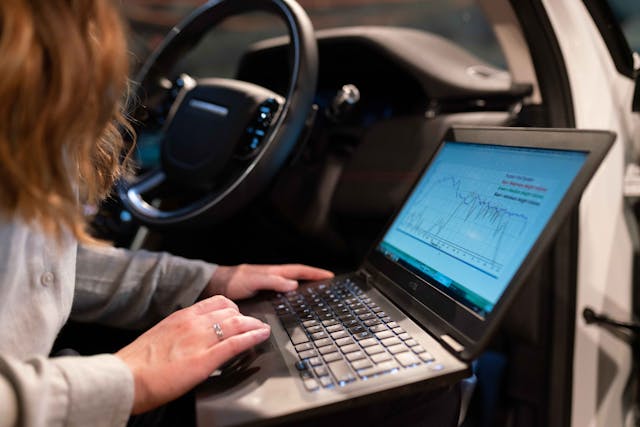Humanity has long dreamed of cars that drive themselves. Thanks to recent leaps in artificial intelligence (AI), that dream is more real than ever. AI isn’t just a buzzword—it’s what’s enabling self‑driving vehicles (SDVs) to sense, think, and act in complex, unpredictable environments. Let’s take a full ride through what this means today, how we got here, what’s possible, what’s risky, and what the road ahead might look like.
What Is a Self‑Driving Car? Autonomous Vehicles Demystified
Levels of Autonomy (Level 0 to Level 5)
Not all “self‑driving” is the same. The industry defines six levels of autonomy (SAE levels):
-
Level 0: No automation; human driver does everything.
-
Level 1: Driver assistance (e.g. adaptive cruise control, lane keeping).
-
Level 2: Partial automation — steering + acceleration/deceleration together, but human driver must monitor and ready to intervene.
-
Level 3: Conditional automation — car handles most tasks in certain conditions; human needed for shape backup.
-
Level 4: High automation — no driver input needed under certain geo/fenced conditions; but not universal.
-
Level 5: Full automation — vehicle can handle every driving scenario under all conditions; no human needed.
Key Components: Sensors, Perception, Planning & Control
To get from “I wish the car could do that” to “the car actually does that,” several systems must work together:
-
Sensors: Cameras, LiDAR, radar, ultrasonic sensors, sometimes infrared. These capture raw data about surroundings.
-
Perception: AI / ML models interpret sensor data: detect other vehicles, pedestrians, road signs, lane lines, obstacles.
-
Planning: Deciding a safe and efficient path, reacting to traffic, choosing brakes/acceleration/steering.
-
Control / Actuation: The low‑level systems that physically steer, brake, accelerate.
-
Localization & Mapping: Knowing where the vehicle is (GPS + high‑definition maps), and how to get where it needs to go.
A Brief History of AI in Autonomous Vehicles
Early Concepts and Milestones
-
Early 20th century: imaginative ideas and prototypes that automated parts of driving.
-
Mid‑1900s: concept cars with “electronic brains” to handle some controls.
DARPA Challenges & the Rise of Big‑Industry Players
-
In the 2000s, DARPA (the U.S. Department of Defense) held Grand Challenges which inspired a wave of research.
-
Companies like Google (later Waymo), Tesla, traditional carmakers began investing heavily.
Modern Advances & Disruptions (2010s–2020s)
-
Major advances in deep learning, sensor tech & computational power.
-
Self‑driving features moved from labs & simulations to test vehicles on public roads.
-
More regulatory attention, startups, pilots & commercial services.
How AI Powers Self‑Driving Cars
Machine Learning & Deep Learning in Perception
Neural networks (convolutional, recurrent, etc.) help cars see: recognizing objects, interpreting road signs, detecting lanes. Deep learning lets the system generalize from many scenarios.
Decision‑Making, Path Planning & Reinforcement Learning
AI isn’t just “seeing” — it must decide: when to slow, when to change lane, how to respond to unusual situations. Reinforcement learning (and hybrid rule‑based systems) are used to teach behaviors and optimize actions over many trials.
Sensor Fusion: Cameras, LiDAR, Radar & More
Each sensor has strengths and weaknesses: LiDAR for depth, radar works well in bad weather, cameras for high detail. Sensor fusion combines them so the AI has a more complete and robust view.
On‑Vehicle Computing vs Cloud / Edge Processing
-
Real‑time decisions often need to be made on the vehicle (“edge computing”), because latency can kill.
-
Less time‑critical tasks (map updates, learning from large datasets) can happen in the cloud. Balancing computation, power use, connectivity is part of the engineering trade‑offs.
The Benefits: Why AI + Autonomous Vehicles Matter
Safety & Reduction of Human Error
Most accidents are caused by human error—distraction, intoxication, poor decision‑making. AI doesn’t tire or get distracted. With good design it promises to reduce crashes dramatically.
Efficiency, Traffic & Environmental Gains
AI‑driven traffic flow (platooning, smoother acceleration/deceleration) can reduce congestion. Optimized routing saves fuel, cuts emissions.
Accessibility & Social Impact
Elderly people, people with disabilities, those who can’t drive—AI cars open mobility possibilities. Also, shared autonomous fleets may reduce need for personal vehicle ownership.
Economic Opportunity & New Industries
From chip makers to mapping companies to AI‑safety specialists, many businesses and job roles are emerging around self‑driving technology.
Major Challenges & Barriers
Technical Edge Cases & Adversarial Environments
Rain, snow, glare, poorly marked roads, unexpected obstacles, pedestrians behaving unpredictably – these are still hard for AI. Also adversarial manipulation (fake signs, etc.).
Regulatory, Legal & Ethical Issues
Who is liable in crashes? What regulations apply? Different countries have different safety standards. AI must obey traffic laws and adapt to local rules.
Public Perception, Trust & Adoption
Many people are wary: safety incidents get big media coverage, people don’t trust the technology. Gaining trust requires transparency, proof, strong safety records.
Data Privacy & Cybersecurity Risks
Self‑driving cars collect a lot of data. Securely storing and using that data is crucial. Also, systems must be safe from hacking — a compromised control system could be disastrous.
Recent Trends & Innovations (2024‑2025)
Vision‑First Approaches & Reducing Hardware Cost
Some companies are trying to rely less on expensive LiDAR or multiple sensors, instead improving algorithms using cameras + radar (vision‐only or vision‑first) to cut cost and weight. This helps scale adoption.
AI Chips & On‑board Processing Power Improvements
New chips (more efficient, faster, lower energy), specialized hardware for inference & real‑time processing are being developed. More compute onboard means less reliance on cloud and better latency.
Robotaxi Deployment, MaaS & Shared Mobility Models
Robotaxi services (autonomous ride hailing) are being tested in several cities; companies envision Mobility‑as‑a‑Service (MaaS) where autonomous fleets serve people rather than everyone owning cars.
Integration with Smart Cities & Infrastructure
Autonomous vehicles work better if the roads, traffic signals, communication systems are “smart” too. Vehicle‑to‑infrastructure (V2I) communication, traffic optimization, updated mapping etc. are increasingly part of the picture.
What the Future Holds: Near‑Term & Long‑Term Outlook
Full Autonomy: When & How?
Level 4 & Level 5 may become more common, but widespread deployment depends on technology reliability, regulatory approval, and infrastructure. We might see selective deployments first (geofenced, controlled scenarios).
Regulatory and Ethical Frameworks Evolving
Regulators are pushing for standardized safety metrics, common rules across regions, clearer liability laws. Ethics experts are involved in decision rules for AI when conflicts arise (e.g. unavoidable accidents).
Role of AI Safety, Explainability & Robustness
AI systems will need to be explainable (why did the car do that?), robust under unusual circumstances, and safe even under sensor failure or ambiguous inputs.
Possible Impacts on Jobs, Urban Planning & Society
Jobs tied to driving (truck, taxi drivers) may shift. Urban design might change: fewer parking lots, more pick‐up/drop off zones. Public transit might integrate with autonomous fleets. There’ll be both gains and disruption.
How to Get Involved / Build Skills in This Field
Key Skills & Knowledge Areas (AI, ML, Robotics, Software)
-
Strong foundation in machine learning / deep learning, computer vision.
-
Understanding of sensor technologies, robot localization & mapping.
-
Control systems, path planning, reinforcement learning.
-
Software engineering, safety, real‑time systems.
Courses, Programs & Nanodegrees
Platforms like Udacity offer specialized programs, e.g. their School of Autonomous Systems.
University programs in robotics / AI also are relevant. Certifications, workshops, and online courses can help.
Hands‑on Projects, Simulators & Open Source
Simulators (Udacity simulator, CARLA, etc.) let you experiment without expensive hardware. Open‑source tools, datasets, community challenges help build experience.
Conclusion
AI in self‑driving cars is one of the most exciting frontiers today. The promise is huge: safer roads, more efficient transport, greater accessibility. But the challenges are real: technical edge cases, regulation, trust, ethics, infrastructure. We’re not fully there yet—but the trajectory is strong. If we navigate carefully (both technologically and socially), autonomous vehicles powered by AI may reshape how we move, live, and interact with our cities in the near future.
FAQs
-
How soon will we see fully autonomous (Level 5) cars on public roads?
It’s hard to give a firm date. Some regions may have limited Level 4 services within a few years in controlled zones. Truly widespread Level 5 in all environments might take a decade or more, depending on technological, regulatory, and societal progress. -
Are self‐driving cars safe?
They have the potential to be much safer than human drivers, especially in avoiding human mistakes (distracted driving, fatigue, etc.). But safety depends critically on how well AI handles rare scenarios, sensor failures, and unexpected events. Extensive testing, monitoring, and regulation are essential. -
What are the biggest technical hurdles right now?
Key hurdles include: handling unusual or adversarial driving conditions (bad weather, weird road markings), reducing dependence on costly sensors, making AI decision‑making explainable, and ensuring robust cybersecurity. -
Will self‑driving cars replace human drivers?
Not immediately. In many places, they’ll augment existing transport (ride sharing, taxis, delivery). Over time, certain sectors (like long‑haul trucking, taxis, shuttle services) might shift heavily. But human oversight, maintenance, and support roles will still be needed. -
What can ordinary people do to prepare for/use this future?
Keep informed, support smart infrastructure demands (e.g. for safe roads and communication systems), and in technical fields: build skills in AI, robotics, software. If interested, try hands‑on work via simulators or small projects. Also engage in public discussion around regulation, safety, and ethics.
Please don’t forget to leave a review.


